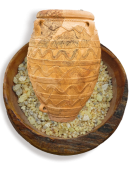
The next known link in wine’s story comes from the Zagros Mountains of Iran where jars unearthed at the excavation site Hajji Firuz Tepe were found to contain traces of tartaric acid, a biomarker for grapes and an almost sure sign that the liquid inside had been wine. The Hajji Firuz Tepe jars were made 7,400 to 7,000 years ago and curiously, they also contained traces of resin from terebinth trees, suggesting that a wine similar to Greek retsina may have been made. Adding resin to wine was an early method of attempting to preserve it, and a way of improving the flavor of a wine gone bad.
Were the makers of the jars at Hajji Firuz Tepe nomadic hunter gathers or had they begun to establish permanent settlements and perhaps even have grown grapes?